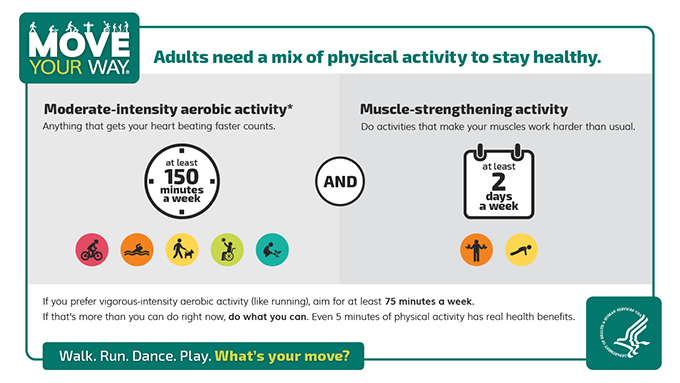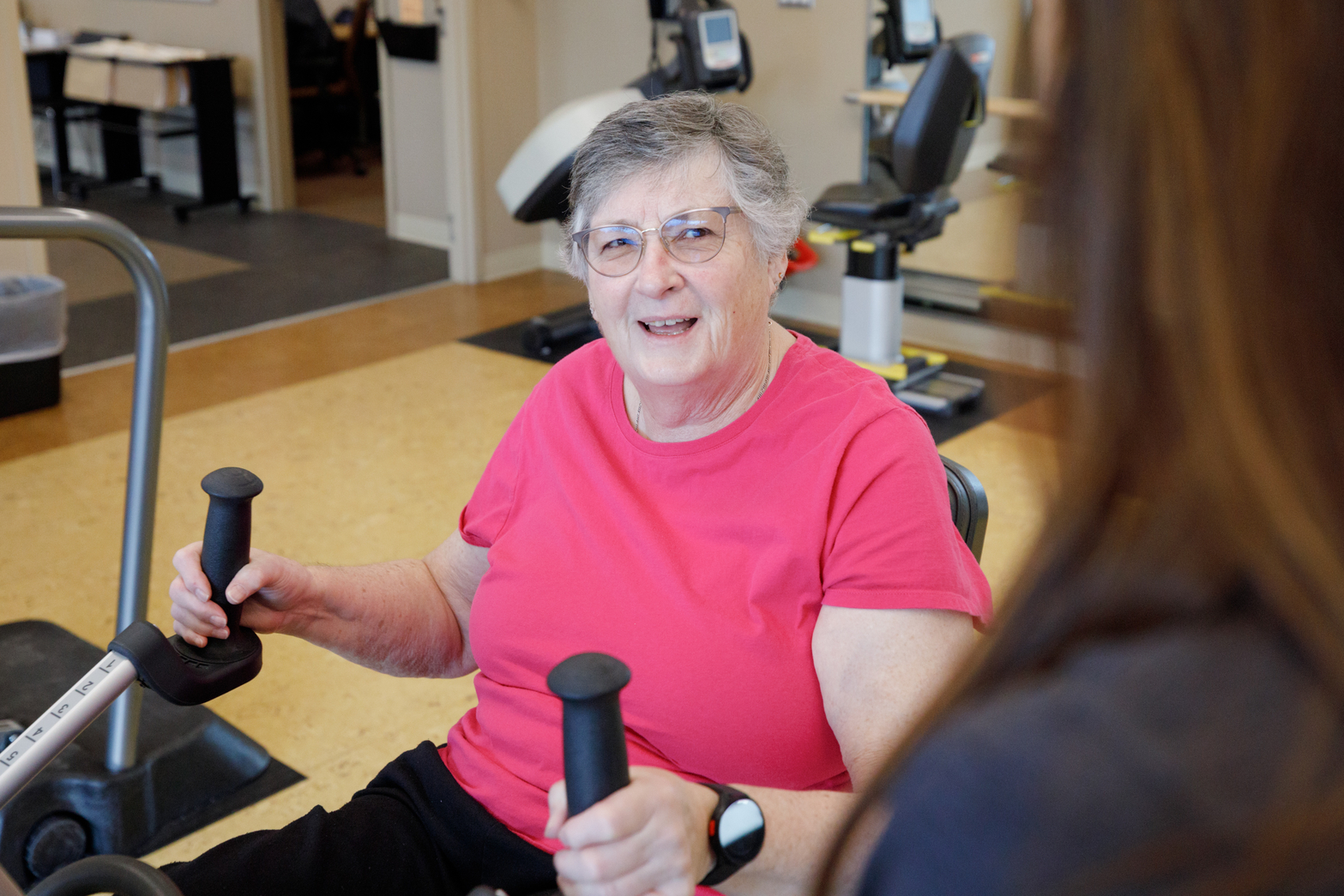Let's Get Moving
Exercise Basics
Learn more about how you can safely exercise and enjoy the benefits of increased physical activity.
Review your latest blood cell counts (lab values) before exercise. If your platelets and/or hemoglobin are low, your exercise routine may need to be limited.
Platelets are blood cells that help your blood to clot and prevent spontaneous bleeding.
- If your platelets are low (less than 5,000) avoid exercise.
- Follow the general guidelines for platelet lab values when exercising.
- Check with your care team if you have any questions.
Hemoglobin is a type of blood cell that helps carry oxygen.
- If your hemoglobin is too low (less than 8), during exercise your body may not have enough oxygen.
- It is important to check with your healthcare team if your hemoglobin is less than 8.
- If you require a blood transfusion, do not exercise until the day after your blood transfusion.
Use the table below to determine whether your exercise should be limited based on your platelet lab values.
| Range | Walking | Biking | Strength Exercises |
| > 50,000 | No limitations | No limitations | No limitations |
| 30,000 - 50,000 | No limitations | No resistance on bike | As tolerated, with light resistance bands only |
| 21,000 - 30,000 | No limitations | No resistance on bike | As tolerated, with light resistance bands only |
| 11,000 - 20,000 | No limitations | No biking | As tolerated, but NO resistance bands or weights |
| 5,000 - 10,000 | No limitations | No biking | Range of motion only |
| < 5,000 | No limitations | No biking | No exercise |
Follow these guidelines for basic tips to maintain safe and satisfying physical activity.
Do:
- Exercise at a comfortable pace. Use the “talk test.”
- Have good fitting and comfortable shoes
- Have water available to stay hydrated
- Warm-up before exercise
- Cool-down after exercise
- Activities should be “joint friendly.” Adjust your activity when you have more joint pain and discomfort than usual, while still trying to stay active.
- When in doubt, use the talk test. When you are being active, just try talking. A moderate level of activity is what we recommend, where you can talk comfortably, but can't “sing.”
Don't:
- Do not hold your breath while exercising
- Do not lift any weights that are too heavy, or use any resistance band that is too hard
- Stop exercise if you are not feeling well or are overly fatigued

These recommendations come from the second edition of the Physical Activity Guidelines for Americans. Experts developed these targets for amount of activity recommended based on the latest research showing how physical activity affects our health.
For more information, click the links below to some fact sheets (PDF files):
Normal Responses to Exercise
The Work Effort Scale describes the target range for how you should feel with exercise and activity.
| WORK EFFORT SCALE | ||
| 6 | Rest |
How you feel when lying in bed or sitting in a chair relaxed. Little or no effort. |
| 7 | Very, Very Light | |
| 8 | ||
| 9 | Very Light | |
| 10 | ||
| 11 | Fairly Light | |
| 12 | |
Target Range: How you should feel with exercise or activity. |
| 13 | ||
| 14 | |
|
| 15 | ||
| 16 | |
|
| 17 |
How you felt with the hardest work you have ever done. Don't work this hard! |
|
| 18 | |
|
| 19 | ||
| 20 | ||
Make Sure to Stay in the Green Zone
| Work Effort | During Exercise | Immediately After Exercise | The Day After Exercise |
Zone 12-14 Somewhat Hard |
• Breathing harder • Slight sweat • Can feel muscles working • Heart beating faster |
• Short recovery (4-7 minutes) • Feel comfortable |
• Comfortable • No aches or pains • Could exercise again |
Zone 15-16 Hard |
• Breathless but not speechless • Sweating • Muscles working hard • Heart beating strongly |
• Short recovery (5-10 minutes) • Comfortable • Feel that muscles have worked • Alert and feeling recharged |
• Not more tired than usual • Feeling of well-being |
|
You are doing too much! |
• Feeling very breathless & speechless • Chest-tightness • Pain • Dizziness • Nauseous |
• Long recovery time (greater than 10 minutes) • Muscles still tense • Heart racing, pounding, fluttering • Nauseous • Dizziness |
• Feeling of no energy or exhausted (more than usual) • Unable to complete your day-to-day activities • Pain |
Four Types of Exercises
Research has shown that it's important to get all four types of exercises: cardio (endurance), strength, balance and flexibility (stretching). Doing one kind also can improve your ability to do the others. Always remember to warm up before and cool down after you exercise.
Cardiovascular (aerobic) activities increase your heart rate and breathing for an extended period of time. This is important to perform everyday activities such as climbing stairs, grocery shopping, and doing housework without undue fatigue and exhaustion. You can build up your endurance gradually, starting with as little as five minutes of activity at a time. Then eventually build up to 30 minutes of activity at least three days per week, eventually
increasing up to five days per week. Examples of cardiovascular activities include: walking, raking leaves, sweeping and dancing.
Recommendations for cancer patients are to include strengthening exercises two times per week for all major muscle groups in the upper body (shoulders, upper arms, back, chest) and in the lower body (hips, thighs, knees, and lower legs).
Level 1 is for the core and legs to maintain your ability to do bed mobility and transfers. Exercises include: bed-based straight leg raise and bed-based bridge.
Level 2 is done while sitting and allows you to start on a stable surface. Pay attention to your core muscles to promote a stable base for your arm and leg muscles to work from. Exercises include: chair stand, arm curl, lateral arm raise, seated knee extension and front arm extension.
Level 3 is done while standing with either body weight or resistance bands. Exercises include: wall push-ups, triceps extension, side leg lifts and calf raises.
Level 4 is a little more advanced. Done while standing, it improves standing tolerance and relates to daily activities. Exercises include: shoulder press, squats, step-ups and three-way leg raise.
Stretching or flexibility exercises are an important part of your physical activity program. Stretching your lower body is important to ensure tasks such as putting your shoes on and picking up items from the floor remain easy and pain free. Stretching your upper body is important to ensure tasks such as brushing your hair and retrieving items from a high shelf (getting food or putting away groceries) remain easy and pain free.
Stretching or flexibility exercises are an important part of your physical activity program. Stretching your lower body is important to ensure tasks such as putting your shoes on and picking up items from the floor remain easy and pain free. Stretching your upper body is important to ensure tasks such as brushing your hair and retrieving items from a high shelf (getting food or putting away groceries) remain easy and pain free.

Weekly Exercise and Physical Activity Plan
If you plan your activities ahead of time, and then keep track of what you have done each week, you may see more success with the incorporation of physical activity into your routine. Click above for a handout to plan and track your activity.